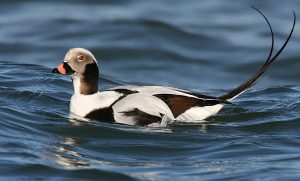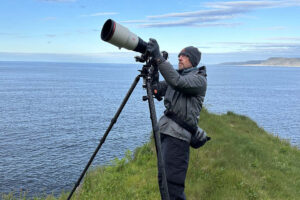 As we anticipate birding over the winter, when waterbirds become more prominent objects of interest, it is useful to take up Bonnie Wood’s reflections on identifying ducks, and the species known now as Longtailed takes on a special interest. Until recently, the species was known in North America as the Oldsquaw, unfortunately preserving old racist stereotypes; the name reflected the loud vocalizations from male ducks—described as yodeling “ow-ow-owlee . . . caloo-caloo” that help identify the species. When members of a flock are all calling together, the effect is strange and farcarrying. Females just offer quacking notes.
As we anticipate birding over the winter, when waterbirds become more prominent objects of interest, it is useful to take up Bonnie Wood’s reflections on identifying ducks, and the species known now as Longtailed takes on a special interest. Until recently, the species was known in North America as the Oldsquaw, unfortunately preserving old racist stereotypes; the name reflected the loud vocalizations from male ducks—described as yodeling “ow-ow-owlee . . . caloo-caloo” that help identify the species. When members of a flock are all calling together, the effect is strange and farcarrying. Females just offer quacking notes.
Unless you spend time on the Long-tailed breeding grounds in the Arctic—where the species is one of the most abundant—you’ll encounter Long-tails only in their nonbreeding plumage, which is quite distinctive. In contrast to their summer plumage (dark above, white below), winter males show a great deal of white: white head with a large black patch, mostly white body. Winter females retain some of their dark breeding plumage but acquire a partly white head with that large black patch. Long-tailed Ducks are quite sociable, and during the winter they form huge flocks on the oceans and bays, such as Puget Sound. Of course, breeding pairs go off by themselves. Courtship begins in autumn but is mostly accomplished from the winter onward as birds mingle during migration. Pairs arrive together on their breeding grounds. They lay their eggs in nests on the ground near water, well-hidden by rocks or vegetation. At the start of egg incubation, males go off to nearby waters to moult, leaving incubation to the females. The young leave the nest shortly after hatching and can already swim and dive well. Their food consists of mollusks, crustaceans, and insects. At sea, they eat primarily mollusks (mussels, clams, periwinkles), crustaceans, and some small fish. On their breeding territory, they eat mostly aquatic insects with some crustaceans and mollusks, but also some plant food. They obtain most of their food by diving, remaining within about 30 feet of the surface though apparently they can dive quite deeply. They land on the water rather clumsily, splashing down breast first, and then dive with their wings partly spread but propelled by their feet. (from Nov/Dec 2016 Echo newsletter, by Burt Guttman), photo – Wolfgang Wander)







